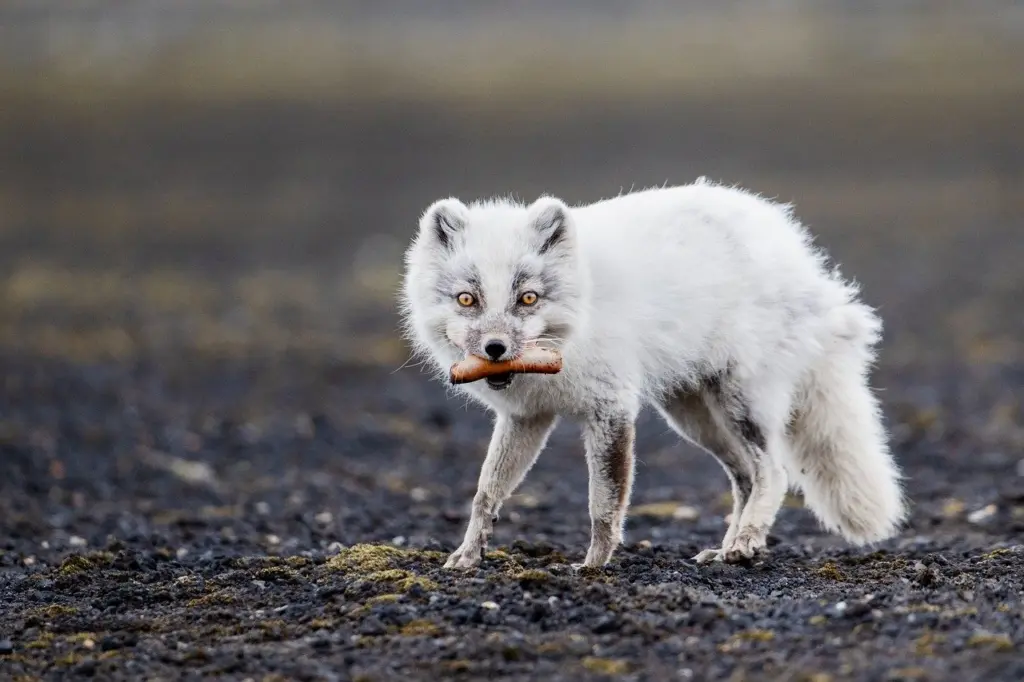In the pristine wilderness of Svalbard, where survival requires extraordinary adaptation and cunning, an unlikely partnership has evolved between two of the Arctic’s most iconic species. While polar bears reign as the undisputed apex predators of this frozen realm, the diminutive Arctic fox has found a remarkable way to thrive alongside these massive carnivores—not as competitors, but as clever opportunists who have turned the bear’s hunting success into their own survival strategy.
Meet Svalbard’s Unlikely Partners
The Arctic Fox: Small but Mighty The Arctic fox of Svalbard represents one of nature’s most perfectly adapted survivors. Measuring only about 60 centimeters in length and weighing between 2.5 and 5 kilograms, these compact mammals have developed extraordinary survival mechanisms that allow them to thrive in one of Earth’s harshest environments.
Their most remarkable adaptation is their thick, multi-layered fur coat that provides insulation against temperatures as low as -30°C and beyond. This coat performs the ultimate seasonal makeover: brilliant white during winter months for perfect camouflage against snow, then transforming to brown or gray during summer to blend seamlessly with rocky terrain and tundra vegetation.
But perhaps their most impressive trait isn’t physical—it’s their intelligence and adaptability. Arctic foxes have developed behavioral strategies that would make any survival expert proud, including their most famous partnership with the Arctic’s top predator.
The Polar Bear: King of the Arctic Polar bears need little introduction as Svalbard’s apex predators. With approximately 3,000 polar bears sharing the Svalbard and Franz Josef Land region, these magnificent creatures dominate the Arctic food chain. Adult males can weigh up to 680 kilograms and stand three meters tall on their hind legs, making them formidable hunters perfectly adapted for life in the Arctic Ocean’s icy waters.
Their primary prey consists of ringed seals, which they hunt with remarkable patience and skill at breathing holes in the sea ice. A successful polar bear hunt can yield substantial amounts of meat—far more than even a hungry bear can consume in a single feeding session. This abundance creates opportunities that Arctic foxes have learned to exploit with remarkable sophistication.
The Art of Arctic Scavenging
The relationship between Arctic foxes and polar bears represents one of nature’s most elegant examples of commensalism—a partnership where one species benefits significantly while the other remains largely unaffected. Arctic foxes have evolved sophisticated behavioral patterns centered around following polar bears and capitalizing on their hunting success.
Following the Giants Arctic foxes demonstrate remarkable tracking abilities, following polar bear scent trails across vast distances of sea ice and tundra. They can detect polar bear presence and the scent of successful kills from distances of 10 to 40 kilometers, using their extraordinarily keen sense of smell to locate feeding opportunities.
This isn’t random wandering—it’s a calculated survival strategy. Foxes learn to read polar bear behavior, recognizing when bears are actively hunting versus when they’re simply traveling. They position themselves strategically, maintaining safe distances while staying close enough to capitalize on hunting success.
Patience and Timing The fox’s approach to scavenging requires remarkable patience and precise timing. They must wait until polar bears have finished feeding and moved away from their kills before approaching the remains. This timing is crucial—approach too early and risk confrontation with a massive predator; wait too long and other scavengers might claim the leftovers.
Arctic foxes have developed the ability to assess polar bear behavior and mood, recognizing when bears are satisfied and likely to abandon their kills. This behavioral reading ability represents sophisticated wildlife intelligence that ensures foxes can access nutrition while avoiding dangerous encounters.
Survival Benefits of the Partnership
For Arctic foxes, this relationship with polar bears provides critical survival advantages that extend far beyond simple nutrition.
Reliable Food Sources In Svalbard’s harsh environment, food sources can be unpredictable and scattered. By following polar bears, Arctic foxes gain access to high-quality protein sources that would otherwise be impossible for them to obtain. Ringed seals, the polar bear’s preferred prey, provide rich nutrition that supports fox survival through harsh winter months.
A single polar bear kill can provide sufficient nutrition to sustain an Arctic fox family for extended periods. The fat and protein content of marine mammals far exceeds what foxes could obtain through their typical diet of small mammals, birds, and carrion.
Seasonal Survival Strategy This scavenging relationship becomes particularly crucial during winter months when other food sources become scarce. While Arctic foxes are capable hunters of lemmings, voles, and birds, these prey species can be difficult to locate under heavy snow cover. Polar bear kills provide accessible nutrition when traditional hunting becomes challenging.
The relationship also provides foxes with mobility advantages. By following polar bears across sea ice, foxes can access hunting grounds and territories that would otherwise be too dangerous or energy-intensive to reach independently.
Ecosystem Interconnections
The fox-bear relationship illustrates the intricate interconnections that define Arctic ecosystems, where each species fills a critical role within a complex web of relationships.
The Ringed Seal Foundation At the base of this relationship lies the ringed seal, Svalbard’s most widespread and common seal species with an estimated population of around 100,000 individuals. These seals serve as the primary prey for polar bears and, indirectly, provide crucial nutrition for Arctic foxes through the scavenging relationship.
Ringed seals themselves depend on sea ice for breeding, creating a three-species relationship where ice conditions affect seal populations, which in turn impact polar bear hunting success, which ultimately influences Arctic fox survival. This interconnection demonstrates how Arctic ecosystems function as integrated systems where changes in one component affect multiple other species.
Sharing the Arctic Landscape The fox-bear relationship also highlights how different species can successfully share the same harsh environment through behavioral adaptation rather than direct competition. Rather than competing for the same resources, foxes have found ways to benefit from polar bear success, creating a win-win situation that exemplifies nature’s problem-solving abilities.
The Intelligence of Arctic Foxes
Arctic foxes demonstrate remarkable intelligence in their interactions with polar bears and their general survival strategies.
Learning and Adaptation Young foxes learn scavenging techniques by observing adult behavior, developing skills in polar bear tracking, risk assessment, and optimal timing for approaching kills. This learned behavior represents cultural transmission that enhances species survival.
Foxes also demonstrate problem-solving abilities in accessing polar bear kills, sometimes working cooperatively to distract bears or accessing food sources from different angles. Their behavioral flexibility allows them to adapt their strategies based on specific circumstances and individual polar bear personalities.
Risk Management Perhaps most impressively, Arctic foxes have developed sophisticated risk management strategies that allow them to benefit from polar bear kills while minimizing danger. They learn to assess individual polar bear behavior, recognizing which bears are more tolerant of their presence and which pose greater threats.
This risk assessment ability extends to environmental factors as well. Foxes learn to approach kills when environmental conditions favor quick escapes, such as when terrain provides multiple escape routes or when weather conditions might mask their presence.
Seasonal Variations in the Partnership
The relationship between Arctic foxes and polar bears changes significantly across Svalbard’s extreme seasonal variations.
Winter Collaboration During winter months, when sea ice provides hunting platforms for polar bears, the fox-bear relationship becomes most active. Polar bears concentrate their hunting efforts on seal breathing holes, creating predictable opportunities for fox scavenging.
Winter conditions also favor fox survival strategies, as their white coats provide perfect camouflage for approaching polar bear kills undetected. The harsh winter environment makes scavenged nutrition particularly valuable when other food sources become scarce.
Summer Adaptations During summer months, as sea ice retreats and polar bears spend more time on land, the relationship dynamics shift. Bears rely more heavily on stored fat reserves and become less active hunters, reducing scavenging opportunities for foxes.
However, summer brings alternative food sources for Arctic foxes, including bird eggs, chicks, and small mammals that become more accessible as snow melts. This seasonal flexibility demonstrates the adaptive strategies that allow both species to thrive in Svalbard’s variable environment.
Conservation Implications
Understanding the fox-bear relationship provides valuable insights for Arctic conservation efforts and ecosystem management.
Climate Change Impacts As Arctic sea ice continues to change due to global warming, the relationship between foxes and polar bears faces new challenges. Reduced sea ice affects polar bear hunting success, which directly impacts the scavenging opportunities available to Arctic foxes.
Changes in ice patterns also affect the accessibility of traditional hunting grounds, potentially altering the geographic areas where fox-bear interactions occur. These environmental changes require both species to adapt their strategies and may influence the long-term viability of their partnership.
Ecosystem Health Indicators The success of the fox-bear relationship serves as an indicator of overall Arctic ecosystem health. When both species thrive in their partnership, it suggests that the fundamental components of the Arctic food web—from seals to sea ice—remain functional.
Monitoring this relationship provides scientists with insights into ecosystem changes and helps identify early warning signs of environmental stress that might affect Arctic wildlife populations.
Observing the Partnership
For wildlife enthusiasts visiting Svalbard, witnessing the fox-bear relationship represents one of the Arctic’s most fascinating behavioral displays.
Photography Opportunities Arctic foxes are considered one of the “big five” animals that photographers hope to capture during Svalbard visits. Their interactions with polar bear territories and scavenging behavior provide unique photographic opportunities that showcase Arctic ecosystem dynamics.
Professional wildlife photographers often focus on capturing images that demonstrate the size contrast between these species and the behavioral strategies that allow them to coexist successfully.
Guided Wildlife Tours Local tour operators offer specialized photo safaris designed to maximize opportunities for observing Arctic fox behavior, including their relationships with polar bears. These guided experiences provide both safety and expert knowledge about wildlife behavior patterns.
Experienced guides understand animal behavior and can position visitors to observe these interactions while maintaining appropriate distances that ensure both wildlife safety and visitor security.
The Broader Ecosystem Web
The fox-bear partnership represents just one example of the complex relationships that define Svalbard’s ecosystem.
Avian Connections Arctic foxes also benefit from Svalbard’s massive seabird populations, particularly around bird cliffs where food sources are abundant during summer months. The same adaptability that allows foxes to follow polar bears helps them capitalize on seasonal bird breeding activities.
Seabird colonies provide eggs, chicks, and adult birds that supplement fox diets when marine mammal scavenging opportunities are limited. This dietary flexibility demonstrates the multiple survival strategies that enable Arctic fox success.
Marine Ecosystem Links The fox-bear relationship ultimately depends on the health of Svalbard’s marine ecosystems. The nutrient-rich waters around Svalbard support massive populations of marine mammals, fish, and invertebrates that form the foundation of Arctic food webs.
These marine connections extend the fox-bear relationship far beyond land-based interactions, linking terrestrial Arctic mammals to ocean productivity and marine ecosystem health.
Lessons in Adaptation
The partnership between Arctic foxes and polar bears offers profound lessons about adaptation, intelligence, and survival in extreme environments.
Behavioral Evolution This relationship demonstrates how behavioral adaptations can be as important as physical adaptations for species survival. While Arctic foxes possess remarkable physical adaptations for cold weather, their behavioral strategies for accessing nutrition may be equally crucial for their success.
The evolution of scavenging behaviors showcases how species can develop sophisticated strategies that maximize survival opportunities while minimizing risks—a balance that requires intelligence, learning, and cultural transmission.
Coexistence Strategies The fox-bear relationship also provides examples of how different species can share challenging environments through complementary rather than competitive strategies. Instead of directly competing for resources, these species have evolved ways to benefit from each other’s success.


